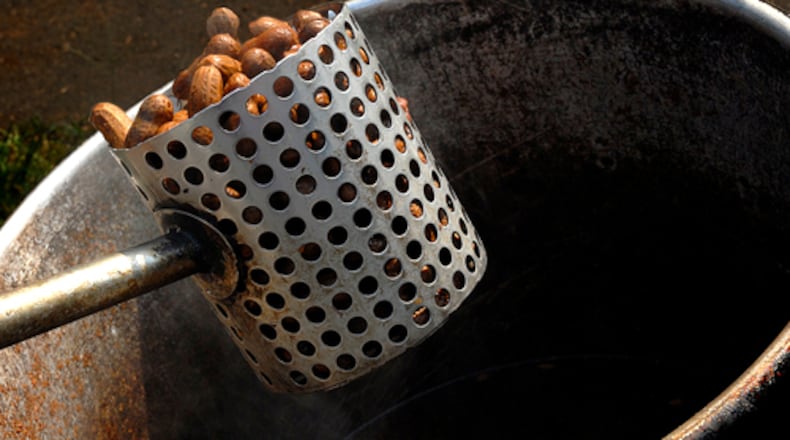“At gas stations in the South, I’ve opened the lids on hot stainless-steel kettles and looked at the boiled peanuts floating there, soggy and a bit slimy, but I have never had the courage to eat them.”
Poor Dorcas Smucker. She doesn’t know what she’s missing.
Smucker is a former contributor to the Register-Guard in Eugene, Oregon. She shared her boiled peanut skepticism with readers of her longtime column, Letters From Harrisburg, after a 2018 trip to South Carolina to see her sister.
Smucker’s fellow Oregonian, Robert Deen, resurrected her quote for the opening pages of his new, self-published “The Boiled Peanut Book,” one that he dedicates to “all those people who are missing one of the greatest treats life offers.”
Deen, 65, has lived most of his life in the Western U.S., but he has Southern roots, although he is no relation to Southern culinary personality Paula Deen, as far as he is aware. Deen was born in Florida. His family moved to Donalsonville, in southwest Georgia, when he was 1-year-old. Four years later, they packed up and headed to California. His affection for boiled peanuts grew not from that brief period living in the Deep South, but from yearly summer road trips to visit relatives in Georgia and the Sunshine State.
“When you hit Louisiana on the eastern side, there would be little boys selling boiled peanuts in a sack,” he told me as we chatted on the phone. For Deen, spotting boiled peanuts for sale on those road trips was “the marker you had made it to the South.”
“We’re almost there,” he’d think to himself.
Deen, who’s now retired, moved from Idaho to Tillamook, Oregon, five years ago, to be closer to his sons and their families in Portland. One of his missions as a grandfather is to spoil his five grandkids with boiled peanuts, and get ’em aboard the bandwagon.
Credit: Robert Deen
Credit: Robert Deen
The book was a project that the self-described “Southern expatriate” had been thinking about for quite some time. The pandemic spurred him to action. “When COVID-19 hit, I needed to come up with things to do,” he said.
Deen’s goal: to make believers out of naysayers, like Smucker. “I’m going to be evangelistic about this,” he said. “People have such a hard time getting their heads around it. I started giving people a copy of the book, and a can of boiled peanuts, and say, ‘Give it a try. Join the Try Club.’”
“Club” is the same term that Southern culinary ambassador Matt Lee used when I called him to discuss the Society of Boiled Peanut Believers. (No such society exists, but it should, and I’d wager that Lee would be a founding member.)
“If you get it, you get it, and you’re part of that club. If you think they are gross, more for me,” said Lee, whose younger brother and business partner, Ted Lee, shares his love of boiled nuts. The Lee Bros. even sell and ship them nationwide, via their website, boiledpeanuts.com.
The brothers were introduced to boiled peanuts when their family moved from New York City to South Carolina in 1979. The setting: a minor league baseball game in Charleston. Boiled peanuts were peddled outside the gates. Fans were munching on them and tossing the shells under the bleachers. The 9- and 7-year-old kids were enthralled.
“We didn’t have any cultural reference to inform us if they were good or bad. We loved them,” Lee said. “We craved the flavor and texture: sauteed mushroom, slightly mealy, always good.”
But, there was more.
“What intrigued us was all these unspoken rules about boiled peanuts,” Lee said. “It was OK to let brine dribble down your finger. Why are they (served) hot in the middle of the summer? There are all these things that don’t add up.”
Another aspect of the boiled-peanut experience is where they are consumed. They’re an outside thing. A gas station thing.
“They are not a restaurant thing,” Lee said, adding: “Some restaurants have broken that rule lately.”
Rule-breakers in Atlanta include SweetWater, whose batches are boiled in the brewery’s 420 Extra Pale Ale and sold in the taproom, and Wood’s Chapel BBQ in Summerhill, where chef and co-owner Todd Ginsberg seasons them with cayenne, Old Bay and lots of salt.
“It’s salty, spicy and something people like to have when having a beer,” Ginsberg said. “We wanted to be a Southern barbecue restaurant. Doing boiled peanuts in the South made a lot of sense for us.”
During the pandemic, they got axed from the Wood’s menu, but will return in a few weeks.
Ginsberg couldn’t get off the phone without telling me his favorite boiled peanut story. He was a presenter at a 2018 Jewish retreat at Camp Ramah Darom in the North Georgia mountains, and found himself driving Jewish culinarian Joan Nathan back to Atlanta, to catch her plane to D.C.
“On the way back, I said, ‘Would you like to stop at one of these market stands?’ She had never tried boiled peanuts. We got a bag. Listening to Joan tell me stories of Wolf Blitzer and Michael Solomonov, and eating boiled peanuts, was something I will remember for the rest of my life,” he said.
Everyone seems to have a boiled peanut story. I suppose it’s time to tell mine.
I’ve forever been a lover of roasted peanuts, an affinity passed down from my dad. For me to thoroughly enjoy them, they have to be in the shell. Separating nut from casing is part of the fun.
But, boiled peanuts are a recent addition to my culinary lexicon. I tasted my first one after moving to Atlanta five years ago. It was slimy and wet. I didn’t get it. I was Dorcas Smucker.
It took multiple tries for this Midwesterner to get excited about sucking the juice from the innards of boiled peanuts, then chomping on the meaty nut.
The “aha” moment occurred when I self-tested another Southern snack: Coke and peanuts. My first try was a complete failure, because I shoved roasted peanuts in the shell down the neck of the glass bottle. The soda was salty, and the prized nuts were stuck inside. Once I understood that peanut shells played no part in Coke and peanuts, I thought that treat was pretty good. Different, unfamiliar, but good. It opened my eyes to the possibilities of peanuts plus liquid.
Credit: Ligaya Figueras
Credit: Ligaya Figueras
In 2016, I happened upon a colorful boiled peanut stand that overlooks Tallulah Gorge in North Georgia. I stared at that big kettle, filled with hot bobbing peanuts, but didn’t have the guts to buy a bag. When I ventured back, a year later, I placed an order and stood around for a few minutes to chat with the peanut man. I wasn’t yet in love with boiled peanuts, but I thought that our relationship had potential.
Pit stops at Southern gas stations are what turned me into a believer. My husband, too.
Now, boiled peanuts are the treat we both look forward to on road trips. We’ll exit the highway, pull into the station, pump gas and head inside. In those few strides to the entrance, I do a finger-cross: Please let there be a barrel of boiled peanuts.
There are times that we get off the interstate and take blue highways. We say it’s for the scenic view, or so we don’t have to grip the steering wheel as tightly. I love those detours, because I secretly hope we’ll come across road shacks, and solitary gas stations with the light still on late at night, boiled peanuts in a vat by the cash register.
Looky there, I’m a proud member of the club.
My excitement over boiled peanuts even prompted me to call Georgia peanut producer Hardy Farms. Shipping has been an issue lately, but they have the goods, whether you want them raw and green, or ready to eat.
These days, I proudly don one of my favorite T-shirts, with the words “Peanut Envy” printed on the front.
I need another, revised, that proclaims: “Boiled Peanut Envy.”
Credit: CONTRIBUTED BY LIGAYA FIGUERAS
Credit: CONTRIBUTED BY LIGAYA FIGUERAS
“We find that half the people that initially reject them come back and love them,” Matt Lee said, as we chatted about peanut varieties, like the Valencia, which offers three or four kernels in a pod, compared with the two kernels in a jumbo Virginia. No matter the variety, “They grow on you,” he said. He noted that the gateway for some skeptics might be to compare boiled peanuts with edamame. Both are salty boiled legumes that promise vegetal flavor.
Poor Dorcas, she doesn’t know what she’s missing.
I felt so badly for Dorcas that I tracked her down and called her. Her befuddlement over boiled peanuts isn’t her fault. She grew up in Minnesota. She lives in Oregon. “I seldom get to the South,” she said.
Her first exposure to boiled peanuts was 15 to 20 years ago, traveling through Georgia. “There were no instructions,” she said. “There they are, floating in hot water. You don’t quite know what to do with such a thing.”
Boiled peanuts again presented themselves to Dorcas on that 2018 trip to South Carolina, where they’ve been the official state snack since 2006. She graciously declined.
I told her my conversion story, and asked whether she’d consider trying them. “If I ever get back to the South, I am going to try them,” she said with conviction, “but I need a native with me, to show me the process.”
Hey, Robert Deen. Grab your book and a can of boiled peanuts. Take a short road trip. Dorcas needs a house call.
Note: Raw green Georgia-grown peanuts can be purchased from Hardy Farms. The company also sells packaged, ready-to-eat boiled and roasted peanuts. Order online or via phone: 888-368-6887, hardyfarmspeanuts.com.
Adapted from “The Boiled Peanut Book,” by Robert Deen (2020).
Read more stories like this by liking Atlanta Restaurant Scene on Facebook, following @ATLDiningNews on Twitter and @ajcdining on Instagram.
About the Author
The Latest
Featured







